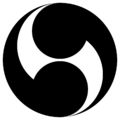Tomoe
Tomoe (巴, also written 鞆絵)[lower-alpha 1], commonly translated as "comma",[2][3] is a comma-like swirl symbol used in Japanese mon (roughly equivalent to a heraldic badge or charge in European heraldry). It closely resembles the usual form of a magatama.
| Part of a series on |
| Shinto |
|---|
 |
| Practices and beliefs |
| Shinto shrines |
| Notable Kami |
| Important literature |
|
| See also |
The tomoe appears in many designs with various uses. The simplest, most common patterns of the device contain from one to four tomoe, and are reminiscent of similar designs that have been found in wide distribution around the world. When circumscribed in a circle, it often appears in a set of three, with this design known as the mitsudomoe (三ツ巴).[4]
Etymology
The character 巴 (Chinese pronunciation bā) has several meanings, ranging from a Sichuan toponym to a crust formed by dryness, parts of the body such as hands or cheeks, and, as a verb, bearing the sense of "to hope", "expect" or "be anxious over". The Chinese character used to depict, according to Bernhard Karlgren's interpretation of the small seal script graph, a python.[5] The Japanese word itself may be of Altaic origin, since it bears comparison with Middle Mongolian tomuγa (twisted horse headdress, from the verb tomu (plait, twist)) and Ordos t'omok ('a little bag hung on a horse's head'). In this latter connection Tang ceramic figures of horses show small sacks tethered to the lower neck, perhaps to stop the horse from throwing its head back.[6]
One view is that the word refers to a picture e (絵) of a tomo (鞆), or drawings on the latter, the tomo in question, in archaic Japanese tömö,[lower-alpha 2] being a round leather arm protector, like the bracer or gauntlet tab of European archery.[9] Roy Andrew Miller describes it as "a small hollow sack or bulb of sewn leather with leather tie straps, sometimes embossed with a comma like decorative device (tomoe) of continental origin".[7] It was worn on the left elbow or wrist of an archer either to prevent chafing from the bowstring (tsuru: 弦) twanging back to position on the release of an arrow, or to strike fear into the enemy from the sharp sound caused by the bowstring hitting the wrist guard.[10][11][7] The 'tomo picture' (tomoe) can therefore be interpreted either as a visual pun on the tomo represented, or, otherwise, as taking its name from that object. Several such examples are conserved in Nara at the Shōsōin. [7]
An alternative interpretation takes it to be a stylized magatama.[12]
Theories of its origin
The origin of the tomoe design is uncertain. A pattern resembling the two-comma tomoe (futatsudomoe) has been found in ancient cultures on all inhabited continents. [13] A stylized design on a Yangshao bowl dates back to 2,000 BCE.[14] The motif of two encircling dolphins biting each other's tails has been found on Cretan ceramics dating from the Minoan period (1700-1400 BCE), and the two fish biting each other in circular fashion recurs in both Chinese and Central Mexican ware.[15] It is frequently seen on prehistoric Celtic remains, and one mirror from Balmaclellan is almost identical to the mitsudomoe. [16] In China, the double comma form came to be assimilated to the Ying-Yang philosophy of opposing male/female principles, formalized in the Tàijítú design of the late Song Dynasty period.[lower-alpha 3] This in turn recurs in the 7th century in Korea, where it was known as Taegeuk.[18] and replicated in the Japanese futatsudomoe and mitsudomoe patterns, the former in association with divinatory rites, the latter frequently linked to temple drums with apotropaic functions.[3] According to Jean Herbert in these contexts, the mitsudomoe embodied three spirits, the yin-yang dyad being represented by an aramitama (rough kami) and a nigimitama (gentle kami), while the third comma denoted the sakimitama, or lucky spirit.[lower-alpha 4]
N. Gordon Munro argued that the basis for the mitsudomoe pattern, a motif found also among the Ainu, was the eastern European and western Asian figure of the triskelion, which he believed lay behind the Chinese three-legged crow design, and, in his view, its reflex in the mythical Japanese crow, the Yatagarasu (八咫烏).[19][20]
Tomoe emblem history in Japan
As a leather[lower-alpha 5] wrist protector tomo appear to have been employed at least as early as the Kofun period, where they are frequently attested on haniwa terracotta figurines depicting archers, [22] and may even have had, aside from their military function, a ritual or fetish value, perhaps related to their testicular shape.[6]
The tomoe emblem established itself as a common emblem during the Fujiwara ascendency of the late Heian period, around the 10th-11th centuries, and proliferated through to Kamakura times. It is thought that a resemblance between the tomoe and the Emperor Ōjin found in the Nihongi may also account for its rising popularity among samurai, since Ōjin was apotheosized as a god in Hachiman shrines.[10][23]
In the Nihongi account, when Ōjin was born, inspection of his body revealed a fleshy growth on his arm similar to a warrior's wrist or elbow pad, and for this reason he was called homuta (誉田: lit.(Lord) Armguard)[24] (OJ: pomuda),[lower-alpha 6] an old word for a tomo.[lower-alpha 7]
Shō clan's family crest


The second Shō clan, who ruled the Ryukyu Kingdom on Okinawa Island from 1470 to 1879, adopted the mitsudomoe as its family crest.[lower-alpha 8] Since it was the royal family crest, its usage was once severely restricted. Okinawans who visited mainland Japan shortly after the abolishment of the polity in 1879 were surprised that mitsudomoe banners were flown everywhere.[28] During the American military occupation of Okinawa, the United States Civil Administration of the Ryukyu Islands (USCAR) made a failed attempt to create the "flag of Ryūkyū" based on the mitsudomoe, only to find the occupied's apathy toward the former royal family's symbol.
Symbolism and uses
The mitsudomoe is closely associated with Shinto shrines, in particular those dedicated to Hachiman, the god of war and archery. Hachiman in Shinto cosmology and ritual, as for example at Hakozaki Shrine, is repeatedly connected with the number three.[29] In Shintoist thinking, this number is taken to represent the three aspects of the four mitama or 'souls' (the other, the kushimitama being considered far rarer).[30]
It is also commonly displayed on banners and lanterns used in festivals and rituals related to Amaterasu-ōmikami,[31] who in the Kojiki confronts her brother Susanoo when he usurps her terrain on earth by dressing as an archer, adorned with magatama beads and 'an awesome high arm-guard' (itu nö takatömö).[lower-alpha 9]
A third element of its symbolic panorama concerns water, an association engendered by its swirling pattern. For this reason, it is said to be located on roofs and gables as a charm against fire.[33]
Since Hachiman was worshipped as the guardian of warriors, it was adopted as a common design element in Japanese family emblems (家紋, kamon) by various samurai clans[34] such as Kobayakawa and Utsunomiya. Among aristocrats, the Saionji family used it as its family emblem. The Koyasan Shingon sect of Buddhism uses the mitsudomoe as a visual representation of the cycle of life.
Tomoe also is a personal name, dating at least back to Tomoe Gozen (巴御前), a famous female warrior celebrated in The Tale of the Heike account of the Genpei War. In Kyoto's Jidai Matsuri festival, she appears in the Heian period section of the procession in samurai costume, and parades as a symbol of feminine gallantry.[35]
The tomoe has also been adopted as a corporate logo in Japan.[36]
Similar designs
The two-fold tomoe is almost identical in its design elements to the Chinese symbol known as a taijitu, while the three-fold tomoe is very similar to the Korean tricolored taegeuk. Also note that the negative space in between the swirls of a fourfold tomoe forms a swastika-like shape, which is fairly prominent in many Indian religions such as Hinduism and Jainism and Buddhism. A similar design can also be found in the some forms of the Celtic spiral triskele as well as with the Basque lauburu and the Sicilian Trinacria.
Gallery
 Futatsudomoe, "twofold tomoe"
Futatsudomoe, "twofold tomoe" Hidari-mitsudomoe ("left threefold tomoe") is widely used in Shinto shrines and as a family emblem
Hidari-mitsudomoe ("left threefold tomoe") is widely used in Shinto shrines and as a family emblem Yotsudomoe ("Fourfold tomoe")
Yotsudomoe ("Fourfold tomoe")
See also
- Gankyil, a symbol in Tibetan and East Asian Buddhism composed of three swirling and interconnected blades
- Gogok, a comma-shaped jewel found in the Korean Peninsula
- Lauburu, the Basque cross
- Mon (emblem)
- Pig dragon or zhūlóng, a zoomorphic stone artifact produced in neolithic China with a C- or comma-like shape
Notes
Explanatory footnotes
- There are in fact seven variants for writing tomoe:ともゑ,巴, 鞆画, 鞆,鞆絵, 艫絵 and 伴絵.[1]
- Roy Andrew Miller vocalizes it tömo. (止毛) I have followed Ōno et al.[7][8]
- Tàijí (太極) being the Primordial One from which the dualities emerged. [17]
- van Gulik citing Jean Herbert, Shintô; at the fountain-head of Japan, Stein and Day, 1967 p.61.[3]
- The Engishiki states that the tomo consisted of an outer covering of bearskin, and an inner sheath of cowhide, though variants with deerskin were also manufactured.[21]
- Pomuda-wakë-nö-mikötö.[25]
- 既産之、宍生腕上、其形如鞆、是肖皇太后爲雄裝之負鞆肖、此云阿叡、故稱其名謂譽田天皇 ('When he was born there was flesh growing on his arm in shape like an elbow pad. As to this resemblance, the Emperor judged that it was the elbow-pad worn as a manly accoutrement. Therefore he was styled by this name, and called the Emperor Homuda'). [26][27]
- Fragmentary sources suggest that the first Shō clan also used the symbol if not as the family crest. American historian George H. Kerr claims that King Shō Toku adopted the mitsudomoe as the crest of the royal house after his successful invasion of Kikai Island in 1465 (Kerr 2011, p. 101).
- 伊都之竹鞆.[32]
Citations
- Brown 1998, p. 186.
- Turnbull 2012, p. 43.
- van Gulik 1982, p. 168.
- Repp 2002, p. 171.
- Karlgren 1974, p. 211.
- Miller 1967, p. 78.
- Miller 1967, p. 77.
- Ōno, Satake & Maeda 1974, p. 926.
- Munro 1911, p. 49.
- SS 1966, p. 121.
- Heldt 2014, p. 191.
- Honda 2004, p. ?.
- Darvas 2007, pp. 37-39.
- Darvas 2007, pp. 36-37.
- Darvas 2007, p. 38.
- Munro 1911, p. 52-53.
- Eberhard 1986, p. 283.
- Snodgrass 2015, p. 569.
- Chamberlain 1982, p. 168,n2..
- Munro 1911, pp. 51,63.
- Munro 1911, p. 50.
- Miki 960, p. 149.
- Numata 1940, p. 151.
- Heldt 2014, p. 209.
- Philippi 1968, p. 572.
- Sakamoto et al. 1967, pp. 105,n.15,363.
- Aston 1972, p. 254.
- Taguchi 1978, p. 7.
- Williams 2007, pp. 163-164.
- Herbert 2010, pp. 42-43.
- Munro 1911, p. 48.
- Philippi 1968, pp. 74-75 and n.5.
- Takamori & Huffman 2007, p. 108.
- Munro 1911, p. 62.
- Bauer & Carlquist 1965, p. 43.
- Garcia 2011, p. 23.
Sources
- Aston, W. G. (1972) [1896]. Nihongi:Chronicles of Japan from the earliest Times to A. D. 697. Volume 1. Tuttle Publishing.CS1 maint: ref=harv (link)
- Bauer, Helen; Carlquist, Sherwin (1974) [1965]. Japanese Festivals. Tuttle Publishing.CS1 maint: ref=harv (link)
- Brown, Steven T. (June 1998). "From Woman Warrior to Peripatetic Entertainer: The Multiple Histories of Tomoe". Harvard Journal of Asiatic Studies. 58 (1): 183–199. doi:10.2307/2652649. JSTOR 2652649.CS1 maint: ref=harv (link)
- Chamberlain, Basil Hall (1982) [1882]. The Kojiki: Records of Ancient Matters. Tuttle Publishing.CS1 maint: ref=harv (link)
- Darvas, György (2007). Symmetry: Cultural-historical and Ontological Aspects of Science-Arts Relations; the Natural and Man-made World in an Interdisciplinary Approach. Springer Science & Business Media. ISBN 978-3-764-37554-6.CS1 maint: ref=harv (link)
- Eberhard, Wolfram (1986). A Dictionary of Chinese Symbols. Routledge. ISBN 978-0-415-00228-8.CS1 maint: ref=harv (link)
- Garcia, Hector (2011). Geek in Japan: Discovering the Land of Manga, Anime, Zen, and the Tea Ceremony. Tuttle Publishing. ISBN 978-1-462-90629-1.CS1 maint: ref=harv (link)
- Heldt, Gustav (2014). The Kojiki: An Account of Ancient Matters. Columbia University Press. ISBN 978-0-231-16388-0.CS1 maint: ref=harv (link)
- Herbert, Jean (2010) [1967]. Shinto: At the Fountainhead of Japan. Routledge. ISBN 978-1-136-90376-2.CS1 maint: ref=harv (link)
- Honda Sōichirō (本田 総一郎) (2004). Nihon no Kamon Taizen (日本の家紋大全). Tokyo: Gotō Shoin (梧桐書院). ISBN 978-4-340-03102-3.CS1 maint: ref=harv (link)
- Takamori, Ikuya; Huffman, Jeff, eds. (2007). Family Crests of Japan. Stone Bridge Press. ISBN 978-1-933-33030-3.CS1 maint: ref=harv (link)
- Karlgren, Bernhard (1974) [1923]. Analytical Dictionary of Chinese and Sino-Japanese. Dover Publications.CS1 maint: ref=harv (link)
- Kerr, George H. (2011) [1958]. Okinawa: The History of an Island People. Tuttle Publishing. ISBN 978-1-462-90184-5.CS1 maint: ref=harv (link)
- Miki Fumio (三木文雄) (1969). Haniwa: the clay sculpture of protohistoric Japan. Tuttle Publishing.CS1 maint: ref=harv (link)
- Miller, R. A. (1967). The Japanese Language. University of Chicago Press.CS1 maint: ref=harv (link)
- Munro, N. Gordon (1911). "Some Origins and Survivals" (PDF). Transactions of the Asiatic Society of Japan. 38: 1–74, 48ff.CS1 maint: ref=harv (link)
- Numata (沼田), Yorisuke (頼輔) (1940). Monshō no Kenkyū (紋章の研究: A Study of Crests). Sōgensha (創元社).CS1 maint: ref=harv (link)
- Ōno Susumu (大野晋); Satake Akihiro (佐竹昭広); Maeda Kingorō(前田金五郎) (1974). Kogo jiten 古語辞典. Iwanami Shoten.CS1 maint: ref=harv (link)
- Philippi, Donald L. (1968). Kojiki. Princeton University Press, Tokyo University Press.CS1 maint: ref=harv (link)
- Repp, Martin (2002). "Protecting kami of the Japanese Nation". In Kubota, Hiroshi; Antoni, Klaus J.; Nawrocki, Johann; Wachutka, Michael (eds.). Religion and National Identity in the Japanese Context. LIT Verlag Münster. pp. 169–191. ISBN 978-3-825-86043-1.CS1 maint: ref=harv (link)
- Sakamoto Tarō (坂本太郎); Inoue Mitsusada (井上光貞); Ienaga Saburō (家永 三郎); Ōno Susumu (大野晋) (1967). Nihon Shoki (日本書紀 ). Iwanami Koten Bungaku Taikei. Volume 67. Iwanami Shoten.CS1 maint: ref=harv (link)
- "Shinto Symbols (Continued)". Contemporary Religions in Japan. Nanzan University. 7 (2): 89–142. June 1966. JSTOR 30232989.
- Snodgrass, Mary Ellen (2015) [2013]. World Clothing and Fashion: An Encyclopedia of History Culture, and Social Influence. Routledge. ISBN 9781317451662.CS1 maint: ref=harv (link)
- Taguchi Nishū (田口二州) (1978). Ryūkyū monshō fu (琉球紋章譜). Hyakunensha (百年社).CS1 maint: ref=harv (link)
- Turnbull, Stephen (2012) [2002]. Samurai Heraldry. Bloomsbury Publishing. ISBN 978-1-782-00014-3.CS1 maint: ref=harv (link)
- van Gulik, Willem R. (1982). Irezumi. Brill Archive. ISBN 978-1-782-00014-3.CS1 maint: ref=harv (link)
- Williams, E. Leslie (2007). Spirit Tree: Origins of Cosmology in Shintô Ritual at Hakozaki. University Press of America. ISBN 978-0-761-83416-8.CS1 maint: ref=harv (link)
External links
| Wikimedia Commons has media related to Tomoe. |